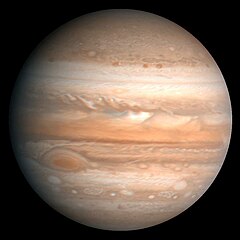
Jupiter is the fifth planet from the Sun and by far the largest within our solar system. Some have described the solar system as consisting of the Sun, Jupiter, and assorted debris,[2]; some describe Jupiter as the solar system's vacuum cleaner, due to its immense gravity well. It and the other gas giants - Saturn, Uranus, and Neptune, are sometimes referred to as "Jovian planets." The Romans named the planet after the Roman god Jupiter (also called Jove). The astronomical symbol for the planet is a stylized representation of the god's lightning bolt.
The Chinese, Korean, Japanese, and Vietnamese cultures refer to the planet as the wood star [3], [4], based on the Chinese Five Elements (curiously enough, through a small telescope, it does somewhat resemble a circular slice of wood in appearance, with the Red Spot being a "knot").
Jupiter has been known since ancient times and is visible to the naked eye in the night sky. In 1610, Galileo Galilei discovered the four largest moons of Jupiter using a telescope, the first observation of moons other than Earth's.
Jupiter is 2.5 times more massive than all the other planets combined, so massive that its barycenter with the Sun actually lies above the Sun's surface (1.068 solar radii from the Sun's center). It is 318 times more massive than Earth, with a diameter 11 times that of Earth, and with a volume 1300 times that of Earth. Quite naturally, Jupiter's gravitational influence has dominated the evolution of the solar system: most planets' orbits lie closer to Jupiter's orbital plane than the Sun's equatorial plane (see illustration), the majority of short-period comets belong to Jupiter's family (a result due to both Jupiter's mass and its relative celerity), the Kirkwood gaps in the asteroid belt are mostly due to Jupiter, and Jupiter is even thought to have been possibly responsible for the late heavy bombardment of the inner solar system's history.
As impressive as Jupiter's mass is, extrasolar planets have been discovered with much greater masses. There is no clear-cut definition of what distinguishes a large and massive planet such as Jupiter from a brown dwarf star, although the latter possesses rather specific spectral lines. Jupiter is thought to have about as large a diameter as a planet of its composition can; adding extra mass would result in further gravitational compression, in theory leading to stellar ignition. This has led some astronomers to term it a "failed star", although Jupiter would need to be about seventy times as massive to become a star.
Jupiter also has the fastest rotation rate of any planet within the solar system, making a complete revolution on its axis in slightly less than ten hours, which results in a flattening easily seen through an Earth-based amateur telescope. Its best known feature is probably the Great Red Spot, a storm larger than Earth which was first observed by Galileo four centuries ago. Indeed, mathematical models suggest that the storm is a permanent feature of the planet. Jupiter is perpetually covered with a layer of clouds, and may not have any solid surface.
Jupiter is usually the fourth brightest object in the sky (after the Sun, the Moon and Venus; however at times Mars appears brighter than Jupiter, while at others Jupiter appears brighter than Venus). It has been known since ancient times. Galileo Galilei's discovery, in 1610, of Jupiter's four large moons Io, Europa, Ganymede and Callisto (now known as the Galilean moons) was the first discovery of a celestial motion not apparently centered on the Earth. It was a major point in favor of Copernicus' heliocentric theory of the motions of the planets; Galileo's outspoken support of the Copernican theory got him in trouble with the Inquisition.
Jupiter is composed of a relatively small rocky core, surrounded by metallic hydrogen, surrounded by liquid hydrogen, which is surrounded by gaseous hydrogen. There is no clear boundary or surface between these different phases of hydrogen; the conditions blend smoothly from gas to liquid as one descends
